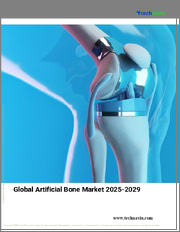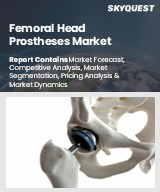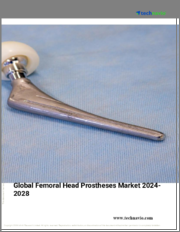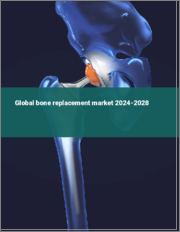
|
시장보고서
상품코드
1577588
세계의 대퇴골 인공관절 시장Femoral Prostheses |
||||||
대퇴골 인공관절 세계 시장은 2030년까지 44억 달러에 달할 것으로 전망
2023년 34억 달러로 추정되는 대퇴골 인공관절 세계 시장은 2023-2030년 분석 기간 동안 연평균 3.9% 성장하여 2030년에는 44억 달러에 달할 것으로 예상됩니다. 이 보고서에서 분석한 부문 중 하나인 대퇴골 머리 부문은 CAGR 4.1%를 기록하여 분석 기간 종료 시점에 32억 달러에 도달할 것으로 예상됩니다. 대퇴골 줄기 부문의 성장률은 분석 기간 동안 CAGR 3.4%로 추정됩니다.
미국 시장 8억 8,550만 달러로 추정, 중국은 CAGR 3.8%로 성장 전망
미국 대퇴골 인공관절 시장은 2023년 8억 8,550만 달러로 추정됩니다. 세계 2위의 경제 대국인 중국은 2023년부터 2030년까지 연평균 3.8%의 성장률을 보이며 2030년에는 7억 760만 달러의 시장 규모에 도달할 것으로 예상됩니다. 다른 주목할 만한 지역 시장으로는 일본과 캐나다가 있으며, 분석 기간 동안 각각 3.7%와 3.2%의 CAGR을 기록할 것으로 예상됩니다. 유럽에서는 독일이 3.5%의 CAGR로 성장할 것으로 예상됩니다.
세계 대퇴골 인공관절 시장 - 주요 동향 및 촉진요인 정리
대퇴골 인공관절이란 무엇이며, 정형외과에서 왜 중요한가?
대퇴골 인공관절은 손상되거나 병든 대퇴골을 대체하기 위해 고안된 인공 임플란트로, 고관절 전치환술(THA) 및 고관절 부분 치환술과 같은 수술에 일반적으로 사용됩니다. 이 인공관절은 대퇴골두 또는 경우에 따라서는 대퇴골 축 전체를 대체하여 고관절의 기능을 회복하도록 설계되었습니다. 심한 골관절염, 골절 또는 퇴행성 관절 질환을 앓고 있는 환자들은 이동성을 회복하고 통증을 줄이기 위해 대퇴골 인공관절이 필요한 경우가 많습니다. 인공관절은 일반적으로 티타늄, 코발트 크롬 합금, 세라믹과 같은 생체적합성 재료로 만들어져 내구성과 신체와의 일체감을 보장합니다. 전 세계적으로 고령화 인구가 계속 증가함에 따라 인공관절의 필요성이 점점 더 커지고 있으며, 인공관절은 심각한 관절 장애를 가진 사람들의 삶의 질을 향상시키기 위한 정형외과적 개입의 핵심이 되고 있습니다.
기술의 발전은 대퇴골 인공관절의 발전을 어떻게 형성하고 있는가?
최근의 기술 혁신은 대퇴골 인공관절의 디자인과 성능을 크게 향상시켰으며, 3D 프린팅과 적층 가공 기술을 통해 각 환자의 해부학적 구조에 맞게 고도로 맞춤화된 임플란트를 제조할 수 있게 되었습니다. 이러한 발전은 더 나은 착용감과 생역학적 적합성을 보장하고, 더 효율적인 회복과 임플란트 수명을 연장할 수 있도록 도와줍니다. 하이드록시아파타이트와 같은 생체 친화적 코팅이 적용된 인공치아를 개발하여 뼈의 성장과 골유착을 촉진하는 것도 큰 진전입니다. 이는 재수술의 흔한 원인인 임플란트 풀림의 가능성을 낮춥니다. 또한, 외과 의사가 수술 중 임플란트 구성요소를 조정할 수 있는 모듈식 대퇴골 인공관절은 유연성과 사용자 정의 가능성을 높여 환자 결과를 최적화합니다. 이러한 기술은 수술의 정확성을 향상시킬 뿐만 아니라 회복 시간을 단축하고 장기적인 결과를 개선하여 재수술 및 재치환의 필요성을 감소시키는 데 기여합니다.
대퇴골 인공관절 시장 성장에 규제 기준과 의료 정책이 필수적인 이유는 무엇인가?
규제 당국의 승인과 의료 정책은 대퇴골 인공관절 시장의 성장을 촉진하는 중요한 요인입니다. 미국 식품의약국(FDA)과 유럽의약품청(EMA)과 같은 규제 기관은 대퇴골 인공 관절을 포함한 의료기기 승인에 대한 엄격한 가이드라인을 마련하고 있습니다. 이러한 규제는 임플란트가 최고 수준의 안전성과 유효성을 충족하는지 확인하여 환자의 안전을 보장합니다. 또한, 의료비 상환 정책의 변화도 시장 역학에 영향을 미치고 있습니다. 정부와 보험 제공자가 성공적인 인공관절 치환술의 이동성 향상과 의료비 절감의 가치를 인식함에 따라, 첨단 대퇴골 인공관절에 대한 보험 적용이 강조되고 있습니다. 이는 병원과 클리닉이 최신 기술과 시술을 채택하도록 유도하여 시장 성장을 촉진하고 있습니다. 이러한 규제 프레임워크와 의료 개혁은 고품질 대퇴골 인공관절에 대한 환자의 접근성을 향상시킬 뿐만 아니라, 제조업체가 엄격한 세계 표준을 충족하는 혁신적인 제품을 개발 및 출시할 수 있는 기회를 제공합니다.
대퇴골 인공관절 시장의 성장을 촉진하는 요인은 무엇일까?
대퇴골 인공관절 시장의 성장은 주로 의료 기술의 발전, 고령화로 인한 수요 증가, 정형외과 건강에 대한 인식 증가 등 여러 가지 요인에 의해 주도되고 있습니다. 특히 노년층의 골관절염, 골다공증 및 외상 유병률의 증가가 주요 요인으로 작용하고 있습니다. 평균 수명이 늘어남에 따라 내구성과 신뢰성이 높은 대퇴골 인공관절의 필요성이 더욱 부각되고 있습니다. 생체적합성 소재의 개발, 3D 프린팅을 통한 맞춤형 임플란트 개발 등 기술 발전 또한 환자의 예후를 개선하고 회복 시간을 단축하는 등 시장 확대에 중요한 역할을 하고 있습니다. 또한, 나이가 들어도 활동적인 라이프스타일을 유지하려는 소비자의 행동이 관절 질환에 대한 외과적 개입을 더 많이 받아들이는 방향으로 변화하고 있습니다. 특히 신흥국의 의료비 지출 증가는 의료 인프라의 확대와 함께 대퇴골 인공관절에 대한 수요를 더욱 촉진하고 있습니다. 마지막으로, 양호한 규제 환경과 지지적인 의료 정책은 계속해서 성장의 원동력이 되고 있습니다. 이는 새롭고 혁신적인 보철 솔루션이 시장에 꾸준히 도입되어 환자와 의료 서비스 제공자 모두에게 이익이 될 수 있도록 보장하기 때문입니다.
조사 대상 기업 예시(총 34건)
- Altimed JSC
- Amplitude Surgical
- Corentec Co.
- Corin Group PLC
- Exactech, Inc.
- Lepu Medical Technology (Beijing) Co., Ltd.
- Medacta International
- Meril Life Sciences Pvt.
- Normmed Medikal ve Makina San. Tic. Ltd. Sti.
- Ortho Development Corporation
목차
제1장 조사 방법
제2장 주요 요약
- 시장 개요
- 주요 기업
- 시장 동향과 성장 촉진요인
- 세계 시장 전망
제3장 시장 분석
- 미국
- 캐나다
- 일본
- 중국
- 유럽
- 프랑스
- 독일
- 이탈리아
- 영국
- 기타 유럽
- 아시아태평양
- 기타 지역
제4장 경쟁
ksm 24.10.31Global Femoral Prostheses Market to Reach US$4.4 Billion by 2030
The global market for Femoral Prostheses estimated at US$3.4 Billion in the year 2023, is expected to reach US$4.4 Billion by 2030, growing at a CAGR of 3.9% over the analysis period 2023-2030. Femoral Heads, one of the segments analyzed in the report, is expected to record a 4.1% CAGR and reach US$3.2 Billion by the end of the analysis period. Growth in the Femoral Stems segment is estimated at 3.4% CAGR over the analysis period.
The U.S. Market is Estimated at US$885.5 Million While China is Forecast to Grow at 3.8% CAGR
The Femoral Prostheses market in the U.S. is estimated at US$885.5 Million in the year 2023. China, the world's second largest economy, is forecast to reach a projected market size of US$707.6 Million by the year 2030 trailing a CAGR of 3.8% over the analysis period 2023-2030. Among the other noteworthy geographic markets are Japan and Canada, each forecast to grow at a CAGR of 3.7% and 3.2% respectively over the analysis period. Within Europe, Germany is forecast to grow at approximately 3.5% CAGR.
Global Femoral Prostheses Market - Key Trends & Drivers Summarized
What Are Femoral Prostheses and Why Are They Vital in Orthopedic Surgery?
Femoral prostheses are artificial implants designed to replace damaged or diseased femoral bones, commonly used in procedures like total hip arthroplasty (THA) or partial hip replacements. These prosthetic devices are engineered to restore the functionality of the hip joint by replacing the femoral head and, in some cases, the entire femoral shaft. Patients suffering from severe osteoarthritis, fractures, or degenerative joint diseases often require femoral prostheses to regain mobility and reduce pain. Prostheses are typically made from biocompatible materials such as titanium, cobalt-chromium alloys, and ceramic, ensuring durability and integration with the body. As the aging population continues to grow globally, the need for femoral prostheses is increasing, making them a cornerstone in orthopedic interventions aimed at improving the quality of life for those with severe joint impairments.
How Are Technological Advances Shaping the Development of Femoral Prostheses?
Recent technological innovations have significantly enhanced the design and performance of femoral prostheses. 3D printing and additive manufacturing techniques have enabled the production of highly customized implants tailored to the specific anatomy of each patient. These advancements ensure a better fit and improved biomechanical compatibility, which translates into more efficient recovery and longer-lasting implants. Another major breakthrough is the development of prostheses with enhanced biocompatibility coatings, such as hydroxyapatite, which promotes bone growth and osseointegration. This reduces the likelihood of implant loosening, a common cause of revision surgeries. Furthermore, modular femoral prostheses, which allow surgeons to adjust the implant’s components during surgery, provide greater flexibility and customization, optimizing patient outcomes. These technologies not only improve surgical precision but also contribute to faster recovery times and better long-term results, reducing the need for follow-up surgeries and revisions.
Why Are Regulatory Standards and Healthcare Policies Essential for the Growth of the Femoral Prostheses Market?
Regulatory approvals and healthcare policies are critical drivers of growth in the femoral prostheses market. Regulatory agencies, such as the U.S. Food and Drug Administration (FDA) and the European Medicines Agency (EMA), have stringent guidelines for the approval of medical devices, including femoral prostheses. These regulations ensure that the implants meet the highest standards of safety and efficacy, providing a safeguard for patients. Additionally, changes in healthcare reimbursement policies are influencing market dynamics. As governments and insurance providers recognize the value of improved mobility and reduced healthcare costs associated with successful joint replacement surgeries, there is a growing emphasis on providing coverage for advanced femoral prostheses. This encourages hospitals and clinics to adopt the latest technologies and procedures, thereby fostering growth in the market. These regulatory frameworks and healthcare reforms not only enhance patient access to high-quality femoral prostheses but also create opportunities for manufacturers to develop and launch innovative products that meet rigorous global standards.
What Is Fueling the Growth of the Femoral Prostheses Market?
The growth in the femoral prostheses market is driven by several factors, primarily centered around advancements in medical technology, rising demand from an aging population, and increasing awareness of orthopedic health. One key driver is the global surge in hip replacement surgeries, which is in part due to the growing prevalence of osteoarthritis, osteoporosis, and trauma-related injuries, especially among the elderly. As life expectancy increases, the need for durable and reliable femoral prostheses becomes more pronounced. Technological advancements, such as the development of more biocompatible materials and personalized implants through 3D printing, have also played a crucial role in market expansion by improving patient outcomes and reducing recovery time. Furthermore, consumer behavior has shifted towards a higher acceptance of surgical interventions for joint problems, as individuals seek to maintain an active lifestyle well into old age. Increasing healthcare expenditure, particularly in emerging economies, combined with the expansion of healthcare infrastructure, is further propelling the demand for femoral prostheses. Lastly, favorable regulatory environments and supportive healthcare policies continue to drive growth, as they ensure a steady introduction of new, innovative prosthetic solutions into the market, benefiting both patients and healthcare providers alike.
Select Competitors (Total 34 Featured) -
- Altimed JSC
- Amplitude Surgical
- Corentec Co., Ltd.
- Corin Group PLC
- Exactech, Inc.
- Lepu Medical Technology (Beijing) Co., Ltd.
- Medacta International
- Meril Life Sciences Pvt., Ltd.
- Normmed Medikal ve Makina San. Tic. Ltd. Sti.
- Ortho Development Corporation
TABLE OF CONTENTS
I. METHODOLOGY
II. EXECUTIVE SUMMARY
- 1. MARKET OVERVIEW
- Influencer Market Insights
- World Market Trajectories
- Impact of Covid-19 and a Looming Global Recession
- Femoral Prostheses - Global Key Competitors Percentage Market Share in 2024 (E)
- Competitive Market Presence - Strong/Active/Niche/Trivial for Players Worldwide in 2024 (E)
- 2. FOCUS ON SELECT PLAYERS
- 3. MARKET TRENDS & DRIVERS
- Rising Incidence of Osteoarthritis and Hip Fractures Globally Throws the Spotlight on the Need for Femoral Prostheses
- Aging Population Worldwide Spurs Significant Demand for Femoral Prostheses in Joint Replacement Surgeries
- Technological Advancements in Prosthetic Materials Strengthens the Business Case for Durable and Long-Lasting Femoral Prostheses
- Shift Towards Minimally Invasive Surgical Techniques Drives Adoption of Advanced Femoral Prostheses
- Increasing Healthcare Spending in Emerging Markets Expands the Addressable Market Opportunity for Femoral Prostheses
- Growing Popularity of Cementless Prostheses Propels Growth in Demand for Innovative Femoral Prosthesis Designs
- Integration of 3D Printing and Customization Technologies Generates New Opportunities for Personalized Femoral Prostheses
- Rising Focus on Post-Surgery Mobility and Patient Outcomes Sustains Demand for High-Performance Femoral Prostheses
- Advancements in Biocompatible Coatings for Femoral Prostheses Drive Demand for Enhanced Bone Integration
- Growing Adoption of Robotic-Assisted Hip Replacement Surgery Strengthens the Business Case for Precision Femoral Prostheses
- Increasing Prevalence of Hip Dysplasia and Other Congenital Conditions Accelerates Demand for Pediatric Femoral Prostheses
- 4. GLOBAL MARKET PERSPECTIVE
- TABLE 1: World Femoral Prostheses Market Analysis of Annual Sales in US$ Million for Years 2014 through 2030
- TABLE 2: World Recent Past, Current & Future Analysis for Femoral Prostheses by Geographic Region - USA, Canada, Japan, China, Europe, Asia-Pacific and Rest of World Markets - Independent Analysis of Annual Sales in US$ Million for Years 2023 through 2030 and % CAGR
- TABLE 3: World Historic Review for Femoral Prostheses by Geographic Region - USA, Canada, Japan, China, Europe, Asia-Pacific and Rest of World Markets - Independent Analysis of Annual Sales in US$ Million for Years 2014 through 2022 and % CAGR
- TABLE 4: World 16-Year Perspective for Femoral Prostheses by Geographic Region - Percentage Breakdown of Value Sales for USA, Canada, Japan, China, Europe, Asia-Pacific and Rest of World Markets for Years 2014, 2024 & 2030
- TABLE 5: World Recent Past, Current & Future Analysis for Femoral Heads by Geographic Region - USA, Canada, Japan, China, Europe, Asia-Pacific and Rest of World Markets - Independent Analysis of Annual Sales in US$ Million for Years 2023 through 2030 and % CAGR
- TABLE 6: World Historic Review for Femoral Heads by Geographic Region - USA, Canada, Japan, China, Europe, Asia-Pacific and Rest of World Markets - Independent Analysis of Annual Sales in US$ Million for Years 2014 through 2022 and % CAGR
- TABLE 7: World 16-Year Perspective for Femoral Heads by Geographic Region - Percentage Breakdown of Value Sales for USA, Canada, Japan, China, Europe, Asia-Pacific and Rest of World for Years 2014, 2024 & 2030
- TABLE 8: World Recent Past, Current & Future Analysis for Femoral Stems by Geographic Region - USA, Canada, Japan, China, Europe, Asia-Pacific and Rest of World Markets - Independent Analysis of Annual Sales in US$ Million for Years 2023 through 2030 and % CAGR
- TABLE 9: World Historic Review for Femoral Stems by Geographic Region - USA, Canada, Japan, China, Europe, Asia-Pacific and Rest of World Markets - Independent Analysis of Annual Sales in US$ Million for Years 2014 through 2022 and % CAGR
- TABLE 10: World 16-Year Perspective for Femoral Stems by Geographic Region - Percentage Breakdown of Value Sales for USA, Canada, Japan, China, Europe, Asia-Pacific and Rest of World for Years 2014, 2024 & 2030
III. MARKET ANALYSIS
- UNITED STATES
- Femoral Prostheses Market Presence - Strong/Active/Niche/Trivial - Key Competitors in the United States for 2024 (E)
- TABLE 11: USA Recent Past, Current & Future Analysis for Femoral Prostheses by Type - Femoral Heads and Femoral Stems - Independent Analysis of Annual Sales in US$ Million for the Years 2023 through 2030 and % CAGR
- TABLE 12: USA Historic Review for Femoral Prostheses by Type - Femoral Heads and Femoral Stems Markets - Independent Analysis of Annual Sales in US$ Million for Years 2014 through 2022 and % CAGR
- TABLE 13: USA 16-Year Perspective for Femoral Prostheses by Type - Percentage Breakdown of Value Sales for Femoral Heads and Femoral Stems for the Years 2014, 2024 & 2030
- CANADA
- TABLE 14: Canada Recent Past, Current & Future Analysis for Femoral Prostheses by Type - Femoral Heads and Femoral Stems - Independent Analysis of Annual Sales in US$ Million for the Years 2023 through 2030 and % CAGR
- TABLE 15: Canada Historic Review for Femoral Prostheses by Type - Femoral Heads and Femoral Stems Markets - Independent Analysis of Annual Sales in US$ Million for Years 2014 through 2022 and % CAGR
- TABLE 16: Canada 16-Year Perspective for Femoral Prostheses by Type - Percentage Breakdown of Value Sales for Femoral Heads and Femoral Stems for the Years 2014, 2024 & 2030
- JAPAN
- Femoral Prostheses Market Presence - Strong/Active/Niche/Trivial - Key Competitors in Japan for 2024 (E)
- TABLE 17: Japan Recent Past, Current & Future Analysis for Femoral Prostheses by Type - Femoral Heads and Femoral Stems - Independent Analysis of Annual Sales in US$ Million for the Years 2023 through 2030 and % CAGR
- TABLE 18: Japan Historic Review for Femoral Prostheses by Type - Femoral Heads and Femoral Stems Markets - Independent Analysis of Annual Sales in US$ Million for Years 2014 through 2022 and % CAGR
- TABLE 19: Japan 16-Year Perspective for Femoral Prostheses by Type - Percentage Breakdown of Value Sales for Femoral Heads and Femoral Stems for the Years 2014, 2024 & 2030
- CHINA
- Femoral Prostheses Market Presence - Strong/Active/Niche/Trivial - Key Competitors in China for 2024 (E)
- TABLE 20: China Recent Past, Current & Future Analysis for Femoral Prostheses by Type - Femoral Heads and Femoral Stems - Independent Analysis of Annual Sales in US$ Million for the Years 2023 through 2030 and % CAGR
- TABLE 21: China Historic Review for Femoral Prostheses by Type - Femoral Heads and Femoral Stems Markets - Independent Analysis of Annual Sales in US$ Million for Years 2014 through 2022 and % CAGR
- TABLE 22: China 16-Year Perspective for Femoral Prostheses by Type - Percentage Breakdown of Value Sales for Femoral Heads and Femoral Stems for the Years 2014, 2024 & 2030
- EUROPE
- Femoral Prostheses Market Presence - Strong/Active/Niche/Trivial - Key Competitors in Europe for 2024 (E)
- TABLE 23: Europe Recent Past, Current & Future Analysis for Femoral Prostheses by Geographic Region - France, Germany, Italy, UK and Rest of Europe Markets - Independent Analysis of Annual Sales in US$ Million for Years 2023 through 2030 and % CAGR
- TABLE 24: Europe Historic Review for Femoral Prostheses by Geographic Region - France, Germany, Italy, UK and Rest of Europe Markets - Independent Analysis of Annual Sales in US$ Million for Years 2014 through 2022 and % CAGR
- TABLE 25: Europe 16-Year Perspective for Femoral Prostheses by Geographic Region - Percentage Breakdown of Value Sales for France, Germany, Italy, UK and Rest of Europe Markets for Years 2014, 2024 & 2030
- TABLE 26: Europe Recent Past, Current & Future Analysis for Femoral Prostheses by Type - Femoral Heads and Femoral Stems - Independent Analysis of Annual Sales in US$ Million for the Years 2023 through 2030 and % CAGR
- TABLE 27: Europe Historic Review for Femoral Prostheses by Type - Femoral Heads and Femoral Stems Markets - Independent Analysis of Annual Sales in US$ Million for Years 2014 through 2022 and % CAGR
- TABLE 28: Europe 16-Year Perspective for Femoral Prostheses by Type - Percentage Breakdown of Value Sales for Femoral Heads and Femoral Stems for the Years 2014, 2024 & 2030
- FRANCE
- Femoral Prostheses Market Presence - Strong/Active/Niche/Trivial - Key Competitors in France for 2024 (E)
- TABLE 29: France Recent Past, Current & Future Analysis for Femoral Prostheses by Type - Femoral Heads and Femoral Stems - Independent Analysis of Annual Sales in US$ Million for the Years 2023 through 2030 and % CAGR
- TABLE 30: France Historic Review for Femoral Prostheses by Type - Femoral Heads and Femoral Stems Markets - Independent Analysis of Annual Sales in US$ Million for Years 2014 through 2022 and % CAGR
- TABLE 31: France 16-Year Perspective for Femoral Prostheses by Type - Percentage Breakdown of Value Sales for Femoral Heads and Femoral Stems for the Years 2014, 2024 & 2030
- GERMANY
- Femoral Prostheses Market Presence - Strong/Active/Niche/Trivial - Key Competitors in Germany for 2024 (E)
- TABLE 32: Germany Recent Past, Current & Future Analysis for Femoral Prostheses by Type - Femoral Heads and Femoral Stems - Independent Analysis of Annual Sales in US$ Million for the Years 2023 through 2030 and % CAGR
- TABLE 33: Germany Historic Review for Femoral Prostheses by Type - Femoral Heads and Femoral Stems Markets - Independent Analysis of Annual Sales in US$ Million for Years 2014 through 2022 and % CAGR
- TABLE 34: Germany 16-Year Perspective for Femoral Prostheses by Type - Percentage Breakdown of Value Sales for Femoral Heads and Femoral Stems for the Years 2014, 2024 & 2030
- ITALY
- TABLE 35: Italy Recent Past, Current & Future Analysis for Femoral Prostheses by Type - Femoral Heads and Femoral Stems - Independent Analysis of Annual Sales in US$ Million for the Years 2023 through 2030 and % CAGR
- TABLE 36: Italy Historic Review for Femoral Prostheses by Type - Femoral Heads and Femoral Stems Markets - Independent Analysis of Annual Sales in US$ Million for Years 2014 through 2022 and % CAGR
- TABLE 37: Italy 16-Year Perspective for Femoral Prostheses by Type - Percentage Breakdown of Value Sales for Femoral Heads and Femoral Stems for the Years 2014, 2024 & 2030
- UNITED KINGDOM
- Femoral Prostheses Market Presence - Strong/Active/Niche/Trivial - Key Competitors in the United Kingdom for 2024 (E)
- TABLE 38: UK Recent Past, Current & Future Analysis for Femoral Prostheses by Type - Femoral Heads and Femoral Stems - Independent Analysis of Annual Sales in US$ Million for the Years 2023 through 2030 and % CAGR
- TABLE 39: UK Historic Review for Femoral Prostheses by Type - Femoral Heads and Femoral Stems Markets - Independent Analysis of Annual Sales in US$ Million for Years 2014 through 2022 and % CAGR
- TABLE 40: UK 16-Year Perspective for Femoral Prostheses by Type - Percentage Breakdown of Value Sales for Femoral Heads and Femoral Stems for the Years 2014, 2024 & 2030
- REST OF EUROPE
- TABLE 41: Rest of Europe Recent Past, Current & Future Analysis for Femoral Prostheses by Type - Femoral Heads and Femoral Stems - Independent Analysis of Annual Sales in US$ Million for the Years 2023 through 2030 and % CAGR
- TABLE 42: Rest of Europe Historic Review for Femoral Prostheses by Type - Femoral Heads and Femoral Stems Markets - Independent Analysis of Annual Sales in US$ Million for Years 2014 through 2022 and % CAGR
- TABLE 43: Rest of Europe 16-Year Perspective for Femoral Prostheses by Type - Percentage Breakdown of Value Sales for Femoral Heads and Femoral Stems for the Years 2014, 2024 & 2030
- ASIA-PACIFIC
- Femoral Prostheses Market Presence - Strong/Active/Niche/Trivial - Key Competitors in Asia-Pacific for 2024 (E)
- TABLE 44: Asia-Pacific Recent Past, Current & Future Analysis for Femoral Prostheses by Type - Femoral Heads and Femoral Stems - Independent Analysis of Annual Sales in US$ Million for the Years 2023 through 2030 and % CAGR
- TABLE 45: Asia-Pacific Historic Review for Femoral Prostheses by Type - Femoral Heads and Femoral Stems Markets - Independent Analysis of Annual Sales in US$ Million for Years 2014 through 2022 and % CAGR
- TABLE 46: Asia-Pacific 16-Year Perspective for Femoral Prostheses by Type - Percentage Breakdown of Value Sales for Femoral Heads and Femoral Stems for the Years 2014, 2024 & 2030
- REST OF WORLD
- TABLE 47: Rest of World Recent Past, Current & Future Analysis for Femoral Prostheses by Type - Femoral Heads and Femoral Stems - Independent Analysis of Annual Sales in US$ Million for the Years 2023 through 2030 and % CAGR
- TABLE 48: Rest of World Historic Review for Femoral Prostheses by Type - Femoral Heads and Femoral Stems Markets - Independent Analysis of Annual Sales in US$ Million for Years 2014 through 2022 and % CAGR
- TABLE 49: Rest of World 16-Year Perspective for Femoral Prostheses by Type - Percentage Breakdown of Value Sales for Femoral Heads and Femoral Stems for the Years 2014, 2024 & 2030



















